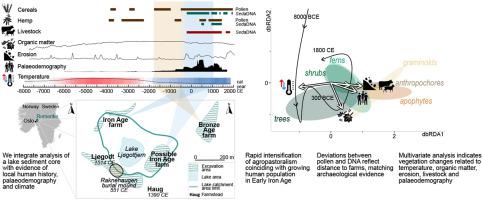Quaternary Science Reviews ( IF 3.2 ) Pub Date : 2021-09-04 , DOI: 10.1016/j.quascirev.2021.107175 A.T.M. ter Schure 1 , M. Bajard 2, 3 , K. Loftsgarden 4 , H.I. Høeg 4 , E. Ballo 2, 3 , J. Bakke 5 , E.W.N. Støren 5 , F. Iversen 4 , A. Kool 6 , A.K. Brysting 1 , K. Krüger 2, 3 , S. Boessenkool 1

|
Uncovering anthropogenic and environmental drivers behind past biological change requires integrated analyses of long-term records from a diversity of disciplines. We applied an interdisciplinary approach exploring effects of human land-use and environmental changes on vegetation dynamics at Lake Ljøgottjern in southeastern Norway during the Holocene. Combined analysis of pollen and sedimentary ancient DNA (sedaDNA) metabarcoding of the sedimentary sequence of the lake describes the vegetation dynamics at different scales, and establishes a timeline for pastoral farming activities. We integrate this reconstruction with geochemical analysis of the sediments, climate data, archaeological evidence of local human settlement and regional human population dynamics.
Our data covering the last 10,000 years reveals consistent vegetation signals from pollen and sedaDNA indicating periods of deforestation connected to cultivation, matching the archaeological evidence. Multivariate analysis integrating the environmental data from geochemical and archaeological reconstructions with the vegetation composition indicates that the vegetation dynamics at Lake Ljøgottjern were primarily related to natural processes from the base of the core (in ca. 8000 BCE, Mesolithic) up to the Early Iron Age (ca. 500 BCE–550 CE), when agricultural activities in the region intensified. The pollen signal reflects the establishment of a Bronze Age (ca. 1800–500 BCE) farm in the area, while subsequent intensification of pollen concentrations of cultivated plants combined with the first sedaDNA signals of cultivation and pastoralism are consistent with evidence of the establishment of farming closer to the lake at around 300 BCE. These signals also correspond to the intensification of agriculture in southeastern Norway in the first centuries of the Early Iron Age. Applying an interdisciplinary approach allows us to reconstruct anthropogenic and environmental dynamics, and untangle effects of human land-use and environmental changes on vegetation dynamics in southeastern Norway during the Holocene.
中文翻译:

全新世期间挪威东南部植被变化的人为和环境驱动因素
揭示过去生物变化背后的人为和环境驱动因素需要对来自不同学科的长期记录进行综合分析。我们采用跨学科方法探索全新世期间人类土地利用和环境变化对挪威东南部 Ljøgottjern 湖植被动态的影响。对湖泊沉积序列的花粉和沉积古 DNA ( sed aDNA) 元条形码的组合分析描述了不同尺度的植被动态,并为牧区农业活动建立了时间表。我们将这种重建与沉积物的地球化学分析、气候数据、当地人类住区的考古证据和区域人口动态相结合。
我们涵盖过去 10,000 年的数据揭示了来自花粉和sed aDNA 的一致植被信号,表明与耕作相关的森林砍伐时期,与考古证据相符。将地球化学和考古重建的环境数据与植被组成相结合的多元分析表明 Ljøgottjern 湖的植被动态主要与从核心底部(公元前 8000 年,中石器时代)到早铁器时代的自然过程有关(约公元前 500 年至公元 550 年),当时该地区的农业活动加剧。花粉信号反映了该地区青铜时代(约公元前 1800-500 年)农场的建立,而随后栽培植物的花粉浓度与第sed aDNA 耕作和畜牧业的信号与公元前 300 年左右在靠近湖泊的地方建立农业的证据一致。这些信号也对应于早期铁器时代最初几个世纪挪威东南部的农业集约化。应用跨学科方法使我们能够重建人为和环境动态,并解开全新世期间人类土地利用和环境变化对挪威东南部植被动态的影响。









































 京公网安备 11010802027423号
京公网安备 11010802027423号